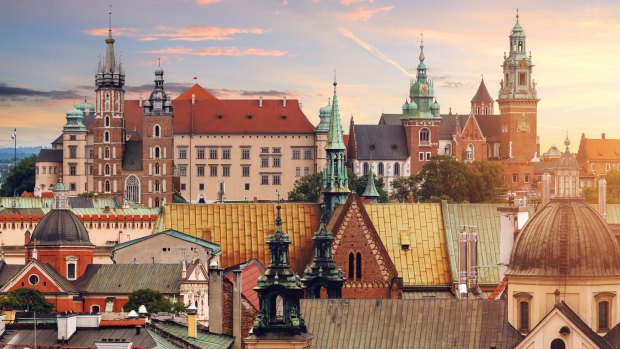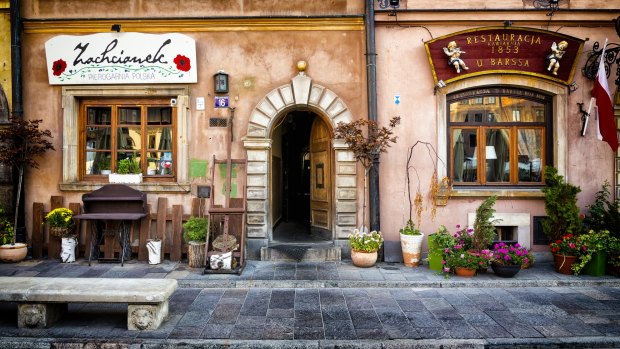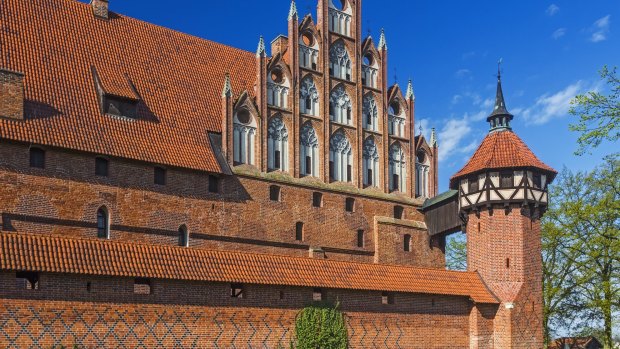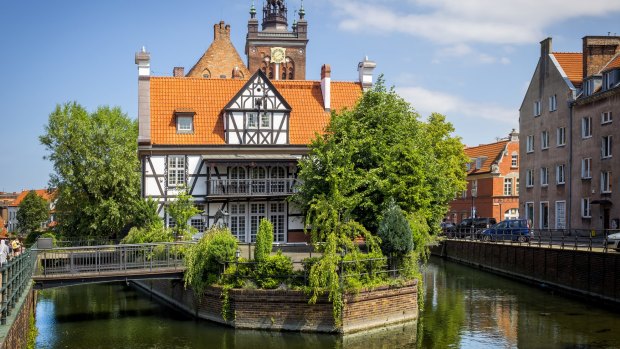This was published 5 years ago
Thirty years after the fall of communism, this is Europe's next boom destination
By Brian Johnston

Gorgeous Krakow at sunset.
If you lived through the 1980s, Poland probably isn't a destination you ever considered visiting. You probably (like I did) have outmoded notions of a dreary communist nation with a horrible history, full of medal-chested Soviet-led leaders and disgruntled shipyard workers. You likely have dim memories of Lech Walesa leading the Solidarity trade union movement that eventually cracked Poland's communist facade.
In the 30 years since the fall of communism in 1989, Poland's peaceful transition to democracy, membership of the European Union and steady economic growth has created few headlines. As a child of the Cold War, what I stored away in my mind about Poland were newsworthy images of the Iron Curtain, army tanks and workers' strikes. Such notions are hard to shake off. I concluded that here was a fringe country whose inhabitants drove tin-can Trabants, ate pickled cabbage and lived in cities of demoralising, disintegrating Soviet apartment blocks.
Now here I am in Warsaw in a state of constant astonishment – and constant dismay at my utter ignorance. Two days into my Collette country-intensive tour of Poland, and my every ridiculous notion is being rapidly reassessed. Warsaw is a city of inconsequential sights – most of it has been rebuilt since World War II – yet with a lovely sense of civilised living. The old town is chipper with orange and yellow facades, well-tended private gardens bloom with hydrangeas, and cafe terraces are chock-full of chirping locals.

Restaurants in the historic centre of Warsaw's old town.Credit: iStock
Warsaw has tree-lined streets and a remarkable abundance of urban parks. Its residents are polite and pleasant. Cultured too. Public benches play you Chopin nocturnes and sonatas as you sit in the sun. A statue of Copernicus sits proudly near the gracious university. No one is ignoring darker history, though. The Museum of the History of Polish Jews sits prominently downtown, a copper-and-concrete monolith that commemorates Poland's once thriving Jewish population.
POLE POSITION
This is just the capital, I think to myself. It will be different elsewhere. Yet it isn't. As Collette wafts me around on an 11-day journey, I find this is the pattern of Poland's reborn cities. Lovely old towns, lovely parks, gentle living. And history. Great dollops of history in ever-increasing layers once we're beyond the formerly bomb-wrecked Warsaw. Before the communists, before World War II, we travel back to a time when Poland was a powerful kingdom at the centre of European affairs, and before that a quilt of prominent duchies and trading leagues.

Malbork Castle, the 13th-century, brick-built headquarters of the Teutonic Knights, is one of the world's largest castles.
We visit eight World Heritage sites on this tour. Churches, castles, entire old towns all lovingly restored over the last decades. All are energetic places full of everyday residents rather than rampaging tourist hordes. Even Malbork Castle is loud with local schoolchildren on excursions. The only exception is Krakow, but it's easy even there to slip sideways, back into the ordinary Poland of regular shopping streets, student canteens and statue-filled parks.
Will that change? Undoubtedly. Prices are low, hotels opening everywhere, the motorway system immaculate, renovations ongoing. Poland seems set to become European tourism's next big thing. It already attracts 18 million visitors annually, which sounds like plenty but pales in comparison to France's 85 million. Beyond Krakow and Gdansk, you'll hear few western European – and even fewer Asian – languages.
COME GDANSK

It's hard to know what to like most about Gdansk.Credit: iStock
Gdansk is the second city on our tour. Many of my travelling companions are American and looking for their Polish roots, which makes for an interesting added dimension to the story of Poland. Our excellent tour manager Marta is herself a Polish-American, with vivid memories of growing up in communist Poland, and with the Polish pride and encyclopaedic knowledge of her country's turbulent history. The Australians are mostly here for a stickybeak, having "done" the rest of Europe and now keen to flee its tourist crowds. We're thanked many times on this trip for naming our highest mountain after Polish national hero Tadeusz Kosciuszko.
Everyone on our tour coach has lived through the 1980s, so there's an excitement about visiting Gdansk, that city of our grainy Eastern Bloc memories. Before we even check into our hotel we make a stop at Lenin Shipyards where electrician Lech Walesa and Solidarity rose in 1980 to protest living standards and oppose the communist government. The movement caused ripples throughout Eastern Europe and brought down the communist leadership in 1989. Walesa later became Poland's freely elected president.
It's only here that I find echoes of the Poland I'd imagined. This part of Gdansk harbour has dilapidated warehouses, rusting cranes and abandoned wharfs, although office blocks and hotels mushroom upwards in the background. The old shipyard guardhouse and gates are still there. Now, though, a soaring steel monument commemorates the 44 striking workers killed during an anti-communist uprising in 1970. Above Gate No. 2 are wooden boards bearing the handwritten demands of the 1980s strikers that led to the Gdansk Accords that legitimised their trade union.
The European Solidarity Centre now sits on this waterfront of brave defiance, its industrial-chic design and contemporary skin of rusting metal echoing the machinery of the shipyards. The museum uses photographs, audio-visual material and displays to tell the stirring tale of the shipyard strikes and how the Solidarity movement contributed to the downfall of communism. I finish in the fresh air on the rooftop terrace. The surrounding shipyards are now much-diminished, but parts have been given over to housing, shopping and entertainment venues in a promising sign of Gdansk's new energy.
A HARROWING HISTORY
Gdansk is nothing if not resilient. It has been a Baltic trading port for 1000 years (the National Maritime Museum fills in the story) and for much of that time was an independent city-state known by its German name Danzig. Fortunes always ebb and flow in port cities, and cultures mingle. The old-town architecture is Germanic, the atmosphere Scandinavian, the blend Teutonic and Slavic.
"Was Gdansk always Polish or always German? The fanatics here on both sides have their version of history, but it's more complicated and interesting than that," says Anna, our thoughtful local Collette tour guide.
Whatever flavour it might have, Gdansk is certainly no longer a dingy industrial city. Maybe it never was. Even the communists recognised the value of its heritage with a sensitive reconstruction of its bombed old town after the war. My preconceptions are dynamited once again as soon as we check into a chic harbourside hotel with its own busy micro-brewery and views over a cheerful waterfront that mixes heritage and contemporary buildings in an interesting but coherent clash of architecture. A stroll beyond, I find myself passing beneath an ornate renaissance gate and into an old town alive with buskers and students, tourists and weekending locals.
The Museum of the Second World War, which opened in 2016 on the waterfront, has become one of Gdansk's most-visited attractions and certainly the most challenging, with many reduced to tears by its harrowing footage and towering wall depicting the faces of some of the 3 million Polish Jews who perished in the Holocaust. If you can face it, this is one of the best war museums anywhere, superbly crafting an unflinching story. While Gdansk is well known for the Solidarity movement, what isn't so known is that the first shots of World War II, which devastated Poland and killed one quarter of its population, were fired in Gdansk harbour.
Good museums, a burgeoning dining scene, a lovely old town and a rich (if sometimes awful) history combine to make Gdansk fashionable these days. Poles want to live in this thriving city by the sea. Sister cities Sopot and Gdynia, just a 30-minute ride away, are salubrious seaside resorts with modernist architecture and fine beaches. Germans and Scandinavians love to visit, and surely the rest of the world won't be far behind. Gdansk has the raffish air of any seaport, squawking with gulls, refreshed by breezes, filled with cheerful bars and beer gardens. Its old town is touristy, but a far cry from Barcelona-touristy. Its post-war renovations were designed to suit residents, not attract tourists, and many remain in the old centre. Beside the amber shops and seafood cafes you'll find green grocers and government offices.
Fortunately, our tour lingers two nights in Gdansk. The journey is relatively leisurely, with built-in free time allowing a great opportunity for self-exploration after local guides have provided an overview. As I wander about, it's hard to say what I like most about Gdansk. The brass ensemble busking under the Green Gate, perhaps. Or the 17th-century Neptune Fountain in the market square, trident uplifted as if about to spear a pigeon. Or the facades adorned with friezes, prancing statues, dragon drainpipes, busts of Polish kings and baroque-age gilt swirls. This was a processional way for Polish kings once, and you'd have to imagine they'd still be pretty pleased with old Gdansk's grand elegance.
I'm pretty pleased myself with Gdansk, and with all the rest of Poland still to come on this journey. Here is a country that has endured horrors and overcome repression, and in a scant 30 years has emerged reinvigorated with all its charm intact. The international tourist crowds will surely be here one day. I just feel pleased I've got here first.
FIVE TOP POLISH DESTINATIONS
KRAKOW
As a former royal capital and centre for Catholicism and intellectual life, Krakow never fared well under communism. Now it's rejuvenated and renovated, from its impressive hilltop castle-and-cathedral complex to its former Jewish quarter, and is Poland's only internationally known and (in places) crowded tourist destination. Sumptuous old-town architecture culminates in famous square Rynek Glowny. Nearby Wieliczka Salt Mines and Auschwitz-Birkenau concentration camp are worthy excursions. See krakow.travel
TORUN
Anywhere else in Europe, a fortified, riverside medieval town would be festooned with souvenir T-shirts, and your dining experience confined to overpriced pizza joints. You won't be bothered by tourism madness here though, despite the wonderful World Heritage architecture and historic connections with great astronomer Nicolaus Copernicus. Slow down and relax. The local speciality is gingerbread; Collette has a very entertaining gingerbread-making experience on its itinerary. See torun.pl
JASNA GORA MONASTERY
This complex outside Czestochowa is a pilgrim destination for millions who come to venerate the Black Madonna, attributed with miraculous curative powers. It's a startling insight into the fervent Catholicism in resurgence in Poland. Pilgrims cram into the Chapel of Our Lady, sometimes circumnavigating the Madonna image on their knees. Next door is a splendid baroque basilica whose treasury glints with bejewelled objects. See jci.jasnagora.pl
WROCLAW
For me Poland's highlight is this city spread over several Odra River islands. Its changing fortunes have bequeathed it Bohemian, Austrian and Prussian-German influences, while its university supplies student liveliness and a humming cultural and nightlife. Its old town's central square is lovelier even than Krakow's (if smaller), and not nearly as touristy. Gothic architecture abounds, but you can also feel the city's commercial energy. See visitwroclaw.eu
MALBORK CASTLE
This 13th-century, brick-built headquarters of the Teutonic Knights is one of the world's largest castles. The High Castle towers over the river and surrounding lower fortifications, all encircled in huge defensive walls. A chapel, impressive refectory and kitchen are among highlights. Our local Collette guide Bart really brought this mainly empty (albeit spectacular) building to life – who knew knights used cabbage leaves as toilet paper? See zamek.malbork.pl
TUCK INTO POLAND
Hearty, home-style cooking is one of Poland's great pleasures. Here are five bargain-priced, must-try stomach fillers.
1. SOUP
Zupy is the core of any Polish meal, and often a meal in itself. The most popular is the sour rye broth zurek (more delicious than it sounds) with egg and sausage; bigos containing sauerkraut and smoked meat; and barszcz, a variant of borscht or beetroot soup.
2.DUMPLINGS
Handmade pierogi, which resemble large ravioli, are filled with cottage cheese, cabbage, mincemeat or potato and topped with fried onion or bacon bits. Dessert dumplings are stuffed with berries, cherries, plums or sweet cheese, topped with cream.
3. SAUSAGES
Kielbasa with bread and mustard is a snack or light meal. White sausage is sliced into soups. There are regional variations in spices such as fennel, caraway seed, garlic or marjoram. Sausages from Krakow are flavoured with garlic and pepper.
4. POTATO PANCAKES
Placki are simple fried pancakes made from grated potato and flour, with egg or apple sauce for binding, eaten topped with sour cream. Similar to hash browns, they can be accompanied by meat, salmon or mushrooms.
5. DOUGHNUTS
Paczki are made from a sweet, rich dough akin to brioche, fluffy thanks to a dash of alcohol that prevents much oil being absorbed during frying. They're filled with jam or contemporary alternatives such as salted caramel. Rosewater jelly is especially delectable.
TRIP NOTES
TOUR
Colette's 11-day country intensive "Discovering Poland" tour has multiple departures from May to October. There are stays in Warsaw, Gdansk, Torun, Wroclaw and Krakow as well as visits to Malbork Castle, Poznan, Czestochowa and Auschwitz. From $2699 pp twin share, including transport, accommodation, guided tours and some meals. Phone 1300 792 196, see gocollette.com
WHEN
Summer sees larger crowds, pleasant mid-20s temperatures and rain showers. September-October is ideal for reliable weather, fewer domestic tourists and shoulder-season prices. Best avoid winter (January-March) when many attractions are closed, snowfall can be heavy and temperatures plunge to -20°C if winds blow from Russia.
VISA
Australian and New Zealand citizens don't require visas for Poland, which is part of the Schengen Area of borderless movement within much of Europe. See canberra.msz.gov.pl
SAFETY
Poland is a very safe destination for travellers, with low risk of terrorism, natural disasters and muggings. However, be vigilant (as anywhere) for pickpockets and bag-snatchers in crowded train and bus stations, on public transport and in busy tourist areas.
Brian Johnston travelled as a guest of Collette.
Sign up for the Traveller Deals newsletter
Get exclusive travel deals delivered straight to your inbox. Sign up now.